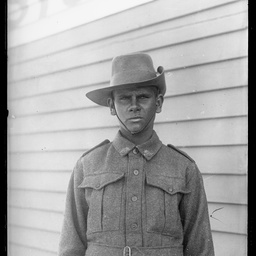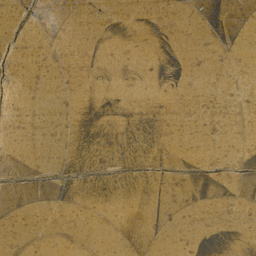Find • port adelaide • Results 9,961 to 9,990 of 9,999


The Old Colonists Banquet Group : Thomas Jones
Thomas Jones arrived in South Australia in July 1840 on board the ship the "Fairlie". Builder, architect, civil engineer; Adelaide, Port Elliot, Moonta.


The Old Colonists Banquet Group : George John Harrison
Arrived in South Australia in April 1840 on board the ship the "Morley". Builder, engine driver, market gardener; Adelaide, Port Elliot, Mitcham.


Bates - Woolfe wedding
Wedding of Shirley Bates of Port Lincoln to Bruce Woolfe, son of Harry Christian Woolfe and Muriel Jean, nee Sweetman, of 6 Owen Street, Goodwood Park, solemnised at the Seventh Day Adventist Church, Angas Street, Adelaide, at 6.30 p.m. on 24 October 1955.


Bates - Woolfe wedding
Wedding of Shirley Bates of Port Lincoln to Bruce Woolfe, son of Harry Christian Woolfe and Muriel Jean, nee Sweetman, of 6 Owen Street, Goodwood Park, solemnised at the Seventh Day Adventist Church, Angas Street, Adelaide, at 6.30 p.m. on 24 October 1955.


Bates - Woolfe wedding
Wedding of Shirley Bates of Port Lincoln to Bruce Woolfe, son of Harry Christian Woolfe and Muriel Jean, nee Sweetman, of 6 Owen Street, Goodwood Park, solemnised at the Seventh Day Adventist Church, Angas Street, Adelaide, at 6.30 p.m. on 24 October 1955.


Bates - Woolfe wedding
Wedding of Shirley Bates of Port Lincoln to Bruce Woolfe, son of Harry Christian Woolfe and Muriel Jean, nee Sweetman, of 6 Owen Street, Goodwood Park, solemnised at the Seventh Day Adventist Church, Angas Street, Adelaide, at 6.30 p.m. on 24 October 1955.


Bates - Woolfe wedding
Wedding of Shirley Bates of Port Lincoln to Bruce Woolfe, son of Harry Christian Woolfe and Muriel Jean, nee Sweetman, of 6 Owen Street, Goodwood Park, solemnised at the Seventh Day Adventist Church, Angas Street, Adelaide, at 6.30 p.m. on 24 October 1955.


Bates - Woolfe wedding
Wedding of Shirley Bates of Port Lincoln to Bruce Woolfe, son of Harry Christian Woolfe and Muriel Jean, nee Sweetman, of 6 Owen Street, Goodwood Park, solemnised at the Seventh Day Adventist Church, Angas Street, Adelaide, at 6.30 p.m. on 24 October 1955.


Bates - Woolfe wedding
Wedding of Shirley Bates of Port Lincoln to Bruce Woolfe, son of Harry Christian Woolfe and Muriel Jean, nee Sweetman, of 6 Owen Street, Goodwood Park, solemnised at the Seventh Day Adventist Church, Angas Street, Adelaide, at 6.30 p.m. on 24 October 1955.


Bates - Woolfe wedding
Wedding of Shirley Bates of Port Lincoln to Bruce Woolfe, son of Harry Christian Woolfe and Muriel Jean, nee Sweetman, of 6 Owen Street, Goodwood Park, solemnised at the Seventh Day Adventist Church, Angas Street, Adelaide, at 6.30 p.m. on 24 October 1955.


Ann and Henry Samuel Wills
Studio portrait photograph of Ann (nee Orsmond) and Henry Samuel Wills Ash in Adelaide. Henry (Harry) Wills was born in 1848 in Devonshire and died 26 June 1927, and Ann (Annie) Wills died 5 July 1917. They lived in Port Augusta.

![Group of [women] Old Colonists : Sarah Rush](https://slsa-collections.s3.amazonaws.com/7b/29/dd35-370d-59c0-9b2e-81e49b26cc69.jpg)
Group of [women] Old Colonists : Sarah Rush
Probably Sarah Rush, c. 1814-1887; nee Brock, married Isaac Rush. Arrived in South Australia in October 1837 on board the ship the "Katherine Stewart Forbes". Resided in Port Lincoln, Adelaide.

![Group of [women] Old Colonists : Sarah Ann Dyke](https://slsa-collections.s3.amazonaws.com/16/3c/9500-ba94-56cc-9c3e-4a4669f3a92c.jpg)
Group of [women] Old Colonists : Sarah Ann Dyke
Sarah Ann Dyke, 1825-1892; nee Stutely, married John Thomas Dyke. Arrived in South Australia in December 1840 on board the ship the "Royal Admiral". Resided in Adelaide, Port Elliot, Victor Harbor.

![Group of [women] Old Colonists : Mary Goodhart](https://slsa-collections.s3.amazonaws.com/93/49/bb88-bf44-5672-90f1-e09c03b748a3.jpg)
Group of [women] Old Colonists : Mary Goodhart
Mary Goodhart, 1841-1936; nee Turner, married George William Goodhart. Born in Adelaide, South Australia to Nancy Turner, nee Mellor, and Joshua Turner. Resided in Kooringa, Port Lincoln, Gilberton.

![Group of [women] Old Colonists : Eliza Eagle](https://slsa-collections.s3.amazonaws.com/28/35/4d09-dab1-5e44-9113-953354eedd4f.jpg)
Group of [women] Old Colonists : Eliza Eagle
Probably Eliza Eagle, 1815-1880; nee Dodman, married Reuben John Eagle. Arrived in South Australia in December 1839 on board the ship the "Moffat". Resided in Port Elliot, Adelaide.


Trucks outside Alf Hannaford and Co. Ltd.
Trucks outside Alf Hannaford & Co., Port Road Woodville '[Alf Hannaford and Co.] make machines for all size farms and they also have a large and well-equipped grading service with a fleet of motor trucks and trained operators to treat farmers' wheat on their farms, which, with a small outlay to the wheat grower results in a bushel to two bushels an acre more gathered from carefully graded and pickled seed.' [Source: Chronicle (Adelaide, SA) 11/10/1934.]


Reginald George Shepherd
Half-plate glass negative of R.G. Shepherd wearing World War One Australian military uniform, including a peaked cap, and holding a whip behind his back. Written on original envelope: '1074 R.G. Shepherd. 1 Doz. P.Cards'.


Harry Havelett
Half-plate glass negative of an Australian soldier, thought to be Private Harry Havelett, wearing World War One military uniform including a slouch hat, standing in front of a building. Written in pencil across top of glass plate: 'Havelet. 9/50. 6 cabs'.


Old colonists 1836-1840 : William Abbott
William Abbott arrived in South Australia from Launceston, Tasmania in May 1838 on board the ship the "Black Joke". Victualler, labourer, farmer; Adelaide, Port Elliot, Encounter Bay.


Old colonists 1836-1840 : Norman Alexander Richardson
Norman Alexander Richardson was born in North Adelaide, South Australia to Anne Harris Richardson, nee Scott, and Oliver Keble Richardson. Mail contractor, pastoralist, Port Augusta.


Old colonists 1836-1840 : Reuben John Eagle
Reuben John Eagle arrived in South Australia in December 1839 on board the ship the "Moffatt". Farmer, Port Elliot; warder, Adelaide Hospital.


HMAS 'Australia' (I) at Melbourne
Written on negative envelope: 'Index no. 65, Subject: H.M.A.S. 'Australia', Melbourne (Ruby's)'. View of the HMAS Australia (I) at port in Melbourne. The battle cruiser HMAS Australia was the Australian Navy's first flagship and the centrepiece of the 'Fleet Unit', whose acquisition signalled the RAN's arrival as a credible ocean-going force. The ship was launched in 25 October 1911, decommissioned on 12 December 1921, and scuttled on 12 April 1924.


HMAS 'Australia' (I) in Sydney
Written on negative envelope: 'Index no. 177. HMAS Australia, Sydney'. Side view of the HMAS Australia (I) at port in Sydney. The battle cruiser HMAS Australia was the Australian Navy's first flagship and the centrepiece of the 'Fleet Unit', whose acquisition signalled the RAN's arrival as a credible ocean-going force. The ship was launched in 25 October 1911, decommissioned on 12 December 1921, and scuttled on 12 April 1924.


HMAS 'Australia' (I) at Sydney
Written on negative envelope: '171. HMAS Australia, Sydney'. View looking towards the bow of the HMAS Australia (I) at port in Sydney. The battle cruiser HMAS Australia was the Australian Navy's first flagship and the centrepiece of the 'Fleet Unit', whose acquisition signalled the RAN's arrival as a credible ocean-going force. The ship was launched in 25 October 1911, decommissioned on 12 December 1921, and scuttled on 12 April 1924.


HMAS 'Australia' (I) at Sydney
Written on negative envelope: '165. HMAS Australia'. View of the HMAS Australia (I) at port in Sydney. The battle cruiser HMAS Australia was the Australian Navy's first flagship and the centrepiece of the 'Fleet Unit', whose acquisition signalled the RAN's arrival as a credible ocean-going force. The ship was launched in 25 October 1911, decommissioned on 12 December 1921, and scuttled on 12 April 1924.


HMAS 'Australia' (I) at Sydney
Written on negative envelope: 'Index no. 135, Subject: HMAS Australia, Sydney'. View of the HMAS Australia (I) at port in Sydney. The battle cruiser HMAS Australia was the Australian Navy's first flagship and the centrepiece of the 'Fleet Unit', whose acquisition signalled the RAN's arrival as a credible ocean-going force. The ship was launched in 25 October 1911, decommissioned on 12 December 1921, and scuttled on 12 April 1924.


HMAS 'Australia' (I) at Sydney
Written on negative envelope: 'Index no. 102, Subject: HMAS Australia - Sydney'. View of the HMAS Australia (I) at port in Sydney. The battle cruiser HMAS Australia was the Australian Navy's first flagship and the centrepiece of the 'Fleet Unit', whose acquisition signalled the RAN's arrival as a credible ocean-going force. The ship was launched in 25 October 1911, decommissioned on 12 December 1921, and scuttled on 12 April 1924.


HMAS 'Australia' (I) at Farm Cove, Sydney Harbour
Written on negative envelope: '304. HMAS "Australia", Farm Cove, Sydney'. Side view of the HMAS Australia (I) coming into port at Farm Cove, Sydney, New South Wales. The battle cruiser HMAS Australia was the Australian Navy's first flagship and the centrepiece of the 'Fleet Unit', whose acquisition signalled the RAN's arrival as a credible ocean-going force. The ship was launched in 25 October 1911, decommissioned on 12 December 1921, and scuttled on 12 April 1924.


Mundy - Purdom wedding
Wedding of Leslie Denise Mundy, elder daughter of David Henry Mundy and Florence Mavis nee Manson of Port Augusta, to Keith Trevor Purdom, youngest son of Percy Edward Purdom and Sarah Mabel ann nee Hodges of Glen Forrest, Western Australia, solemnised at St. Paul's Pulteney Street, Adelaide, on Saturday 18 February at 2.30 p.m.

Photographs of General Motors-Holden's Limited in South Australia: Miscellaneous
Photographs from a group titled 'Miscellaneous' of scenes associated with General Motors-Holden's Limited, comprising images of the 1938 Holden display at the Adelaide Show, World War II equipment and officials inspecting GMH produced items, GMH staff badge monogram and women's uniforms, Air Raid Precautions room and trenches at GMH Plants, Welfare Officer's rooms, foundry, GMH Woodville Port gate, Finsbury Plant, trainees and apprentices, knock off time at GMH Woodville Plant and night of SA coal strike, functions and events such as the GMH ball, lunchtime activities such as wrestling, bowls, quoits, table tennis, basketball, chess, indoor cricket, darts and concerts, Cricket Club dinner, 1945 Christmas Party, Debate Dinners, and the 1940 Chevrolet Convention at Birkenhead Plant. Also contains photographs of GMH associated South Australian manufacturing business Plants including those of Horwood Bagshaw Ltd., Mason & Cox steel foundry, Philmac Limited, Pope Products, Perry Engineering Limited, K. Bowes & Co., Wiles Chromium Company, Kelvinator Plant and Diecaster Plant.
